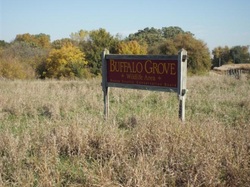-
Government
- Perry Next
-
Resident Info
- AmeriCorps Perry
- Tree Trimming and Ash Tree Removal
- City Projects Blog
- Downtown Improvements
- City Newsletters
- Public Service Announcements
- Snow Ordinances
- Fireworks
- Waste Water Treatment Plant Project
- Pet Registration
- Garbage & Recycling
- Yard Waste
- Property Maintenance
- Rental Property Code Enforcement
- Community Calendar
- Contacts & Staff Directory
- Links of Interest
- Maps
- Media/ News
- Chamber of Commerce
-
Business & Development
- Culture & Recreation
- I Want To . . .
|
According to a 1949 historical article by E.N. Hastie, our community’s history probably began with a pioneer settlement called Buffalo Grove. Mr. & Mrs. John Moore of Champaigne County, IL, along with their family and a few relatives, traveled to this area in the fall of 1849, arriving on November 17th. Trees were less plentiful on open prairie then, and they decided to settle at a place known as Buffalo Grove. It was north and east of our present city, along Beaver Creek mostly in southern Boone County, with some in far northern Dallas County. The grove, nine miles long and ¼ mile wide, had walnut, oak, hickory trees and was named as the place the last buffalo in this area fed and were shot. Some of this group of only 17 decided to go east to a thriving community of Xenia.
Those who wanted to homestead shared a common, crude hut for the winter. Cabins were built in the spring of 1850 and a settlement took shape. It is said plenty of deer, elk, and turkey were available for food, while also being killed to protect crops. Within six years the Moore Cemetery started, a school was built, and Union Township of Boone County was formed. A lot of this community was near the present Perry Country Club. A town to be called Unionville was laid out in 1858 but was never developed. By 1861 two school districts were formed, called Lincoln and Douglas. Those districts survived into the mid 1940’s with the one room schools finally being removed in the mid 50’s. Many more settlers had arrived and early promoters of the community besides the Moores were Edward Vail, Calvin Brown, and James Morse. By this time, Alton had started and Perry was plotted. Some residents went into business in Perry. The community’s crops grew but the population did not. Very little specific information is known, and all that is left today is that cemetery. It was cleaned up and restored as much as possible by George Carpenter in 1977. It is on private property, slightly north of the Country Club. The caring landowners keep the plot clean and mowed, and they also maintain access to it. There are likely less than 30 graves there with the most recent found dated 1880. Most of these permanent residents passed on in the 50’s, 60’s and 70’s, of the 19th century. A veteran or two are buried there from the Civil War. The harshness of living in the era is seen by averaging out the age of those who died. Full information just isn’t available but what can be seen is that the average age of the few recorded deaths was under 18 years. Doctors and simple medicines were not known commodities and life was very hard. A few left their homes and families to enlist in the war effort, like Ney Pots, forever age 16 and one of the marked graves at the Moore Cemetery. Comments are closed.
|
Historic Preservation CommissionArchivesCategories
All
|
-
Government
- Perry Next
-
Resident Info
- AmeriCorps Perry
- Tree Trimming and Ash Tree Removal
- City Projects Blog
- Downtown Improvements
- City Newsletters
- Public Service Announcements
- Snow Ordinances
- Fireworks
- Waste Water Treatment Plant Project
- Pet Registration
- Garbage & Recycling
- Yard Waste
- Property Maintenance
- Rental Property Code Enforcement
- Community Calendar
- Contacts & Staff Directory
- Links of Interest
- Maps
- Media/ News
- Chamber of Commerce
-
Business & Development
- Culture & Recreation
- I Want To . . .

